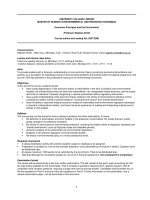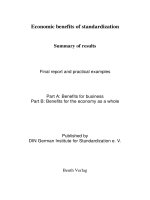Economic benefits of standardization Summary of results Final report and practical examples pdf
Bạn đang xem bản rút gọn của tài liệu. Xem và tải ngay bản đầy đủ của tài liệu tại đây (184.58 KB, 39 trang )
Economic benefits of standardization
Summary of results
Final report and practical examples
Part A: Benefits for business
Part B: Benefits for the economy as a whole
Published by
DIN German Institute for Standardization e. V.
Beuth Verlag
Page 2 Economic benefits of standardization: Summary
Economic benefits of standardization: Summary Page 3
Contents
Foreword 4
Preface 6
Part A: Benefits for business
The effects of standardization: Results of the company survey and
interviews with experts (with references to examples) 8
Technical University Dresden, Faculty of Economics and Business Management
Prof. Dr. Armin Töpfer, Chair of Coorporate Management and Marketing
Prof. Dr. Ulrich Blum, Chair of Economic Policy and Economic Research
Dipl Vw. Gisela Eickhoff
Dipl Vw. Isabelle Junginger
1. Strategic significance of standardization 9
2. Potential competitive advantage through standards 10
3. Standards in global markets 11
4. Cost reduction through standardization 13
5. Effects of standards on the supplier-client relationship 14
6. Standards and the formation of strategic alliances 14
7. Standards and research and development 15
8. Reaction time of standardization 16
9. Product safety and liability 17
10. Public interest 17
11. Standards work 18
12. Standards bodies 19
Part B: Benefits for the economy as a whole
Standardization and technological change, the effects of standardization on
the German economy and foreign trade 20
Fraunhofer Institute for Systems and Innovation Research (FhG-ISI),
Karlsruhe
Dr. Knut Blind
PD Dr. Hariolf Grupp
Dipl Vw. Angela Hullmann
Dr. Andre Jungmittag
1. Approaches and objectives 20
2. Results of the analysis of the connection between standardization and
technological change 20
3. Significance of standardization for the economy as a whole 22
4. Significance of standards for foreign trade 23
5. Comparison of the results of the macroeconomic analyses with those
of the company survey 26
Conclusion by the participating research institutes 30
Practical examples Dr Ing. Bernd Hartlieb (DIN) 31
Page 4 Economic benefits of standardization: Summary
Foreword
In recent years, technical standardization has been the subject of numerous aca-
demic research projects. Although these projects did not ignore economic aspects,
they lacked the theoretical background necessary for a detailed analysis. Industry
has become increasingly interested in assessing its economic efficiency, and thus is
more interested in the role of standardization.
Systematic and reliable results can only be attained on a common basis. Because
there is greater pressure on industry to rationalize, the costs and benefits of stan-
dardization must be examined from both a microeconomic and a macroeconomic
viewpoint. The Presidial Board of DIN therefore asked research institutes to initiate
research into the economic efficiency of standardization, with the aim of making the
costs and benefits of standardization transparent from both economic perspectives.
DIN, the German Institute for Standardization, contracted the Fraunhofer Institute
for Systems and Innovation Research Karlsruhe (ISI Karlsruhe) and the Depart-
ments of Market-Oriented Business Management and of Political Economics and
Economic Research at the Technical University Dresden to jointly carry out this
research project in Germany, Austria and Switzerland.
This final report on "The economic benefits of standardization" presents the conclu-
sions of the research carried out in these three nations, with the following conclu-
sions:
As expected, company standards have the greatest positive effect on businesses, for
they help improve processes. When it comes to the relationship with suppliers and
customers, however, industry-wide standards are the main instruments used to
lower transaction costs and assert market power over suppliers and customers. In
fact, industry-wide standards play a vital role in our increasingly globalized world.
84% of the companies surveyed
1
use European and International Standards as part
of their export strategy, in order to conform to foreign standards.
From a macroeconomic perspective, it is significant that standards make a greater
contribution to economic growth than patents or licences, that export-oriented sec-
tors of industry make use of standards as a strategy in opening up new markets, and
that standards help technological change.
This research project shows that industry-wide standards not only have a positive
effect on the economy as a whole, but also provide benefits for individual busi-
nesses who use them as strategic market instruments.
We would like to express our gratitude to the following companies and institutions
for their financial support and willingness to provide a forum for discussion during
the research project:
– the German Federal Ministry of Economics and Technology (BMWi),
– DaimlerChrysler AG,
– the German Electrotechnical Commission of DIN and VDE,
1
In the company survey carried out by the TU Dresden and presented in Part A of this document.
Economic benefits of standardization: Summary Page 5
– Hans L. Merkle-Stiftung im Stifterverband für die Deutsche Wissenschaft
(Bosch),
–SiemensAG,
– ThyssenKrupp AG,
– the Austrian Standards Institute (ON),
– the Swiss Association for Standardization (SNV).
In addition to the present summary of research results, the Beuth Verlag has pub-
lished the full reports of the participating institutes
2
.
Dr Ing. Torsten Bahke
Director of DIN
2
Gesamtwirtschaftlicher Nutzen der Normung, Unternehmerischer Nutzen 1, Wirkungen von
Normen: Ergebnisse der Unternehmensbefragung und der Experteninterviews
(in German)
Gesamtwirtschaftlicher Nutzen der Normung, Unternehmerischer Nutzen 2, Statistisches Mate-
rial und Auswertung (in German)
Gesamtwirtschaftlicher Nutzen der Normung, Volkswirtschaftlicher Nutzen, Zusammenhang
zwischen Normung und technischem Wandel, ihr Einfluss auf die Gesamtwirtschaft und den Au-
ßenhandel der Bundesrepublik Deutschland (in German)
Page 6 Economic benefits of standardization: Summary
Preface
The development of standards and technical rules by institutions given authority to
do so by both the private and public sectors is an essential element of the tech-
nological and economic infrastructure of a nation, and greatly influences its com-
petitive ability and the strategies of companies. Increasing globalization has dra-
matically changed the international business environment. This fact, together with
the changing role of standardization within the European and international contexts,
make it necessary to examine both the form and content of standardization proce-
dures in order to identify the economic implications of standards and technical
rules.
The joint research project "Economic benefits of standardization" was carried out
simultaneously in Germany, Austria and Switzerland, having been initiated by DIN,
the German Institute for Standardization. DIN contracted the Department of Mar-
ket-Oriented Business Management and the Department of Political Economics and
Economic Research at the TU Dresden and the Fraunhofer Institute for Systems and
Innovation Research, Karlsruhe to carry out the project. Part A, "The effects of
standardization: Results of the company survey and interviews with experts" was
carried out by the TU Dresden, and Part B, "Standardization and technological
change, the effects of standardization on the German economy and foreign trade"
was researched by the Fraunhofer Institute. Due to technical and organizational
limitations, the study only dealt with selected aspects of the economic implications
of standardization.
This analysis of the economic benefits of standardization takes as its starting point
the four main partners in standardization: businesses, private households, the state
and the standards body; the latter acts as an intermediary between the other three.
These three are affected by standardization in different ways. Their reactions and
their motivation to become involved in standardization work form the basis of the
research by the TU Dresden. In contrast, the Fraunhofer Institute adopted a macro-
economic approach, concentrating on the link between standardization and techno-
logical change, and the relationships between standardization, economic growth and
exports. Together, the two parts of this study provide an interdependent analysis of
the microeconomic and macroeconomic effects of standardization.
The research undertaken by the TU Dresden aimed to identify the economic effects
of standardization. Starting with a theoretical framework, the effects of standards on
individual businesses, particular sectors, and the economy as a whole were exam-
ined. Of particular interest were the sources of motivation for participating in the
standardization process. The hypothetical framework was tested in a company sur-
vey carried out in Germany, Austria and Switzerland. In addition, interviews were
held with German and Austrian experts who represent the interests of private
households and the state.
Economic benefits of standardization: Summary Page 7
The Fraunhofer Institute concentrated its research on the link between standardiza-
tion and technological change. The question here was to find our whether the form
and content of standards have a positive influence on technological change in Ger-
many, and whether the standardization process responds to this change enough to
give Germany an advantageous position in the global market. In conclusion, the
implications of these factors for economic growth and export are assessed, and the
results compared with the responses to the company survey.
Dresden and Karlsruhe, April 2000 The Authors
Page 8 Economic benefits of standardization: Summary
Part A: Benefits for business
The effects of standardization: Results of the
company survey and interviews with experts
The four partners in the standardization process are
linked in a number of ways. A framework of hy-
potheses was established on the basis of the litera-
ture and the principles of industrial economics. A
company survey was then carried out in Germany,
Austria and Switzerland to check the validity of
these hypotheses. Module 4,
3
which includes the
results of the company survey, examines in detail
whether there were any fundamental differences
between the responses from the three countries.
In close cooperation with the national standards
bodies, ten sectors of industry were selected, in eight
of which standardization activity is particularly in-
tense. For control purposes, two sectors in which
there is less activity were also selected. Over 4,000
companies were selected at random and sent a
printed questionnaire. The response rate was over
17%, giving 707 completed questionnaires for
evaluation. The questionnaire contained 49 ques-
tions covering more than 340 details.
The other partners in standardization, private house-
holds and the state, were represented in interviews
carried out with ten experts each in Germany and
Austria.
The present summary presents the most significant
empirical results of the company survey and the ex-
pert interviews, which are compared with the above-
mentioned hypotheses. A more extensive discussion
of these results is presented in module 5.
3
The results of this study are divided into five modules.
Module 3 contains theoretical details, module 4 presents
empirical results, and module 5 presents the fusion of the-
ory and practice. (These modules are published as a series
of reports, see page 5, footnote 2.)
Hypotheses were
checked for validity in
a company survey and
interviews with experts
A survey of over 4,000
companies in Germany,
Austria and Switzer-
land was carried out
Response rate over
17%
Expert interviews were
held with representa-
tives of public interest
groups, private house-
holds and the state
Economic benefits of standardization: Summary Page 9
This study focuses on the effects of standards on a
company, as well as on that company's interaction
with its immediate business environment. These
effects have a direct influence on company strategy.
In particular, the study concentrates on the effects of
standards on costs in general, on research and devel-
opment, and safety. The effects on the company's
own business sector include potential competitive
advantages over other companies, and the formation
of strategic alliances. Finally, the relationship be-
tween the company and its national standards body
was examined.
1. Strategic significance of standardization
In a situation analysis initiated by DaimlerChrysler
AG, experts from business, research, industrial or-
ganizations and standards institutes established that
the relevance of standards could be demonstrated in
"numerous arguments, illustrations and examples"
4
.
However, although this information is well-known
to standardizers, decision-makers within companies
seem hardly aware of it. This inadequate information
means that the strategic potential of standards is not
fully appreciated, and the decision to participate in
the standardization process is made only on the basis
of how time-consuming and costly this will be.
The company survey revealed that even though
some companies are not sufficiently well-informed,
they are at least partly aware of the strategic poten-
tial of standardization and can benefit from it.
An example of this can be seen in the fact that 75%
of the businesses surveyed confirmed that they are
involved in activities at the German Institute for
Standardization (DIN), the Austrian Standards In-
stitute (ON) or the Swiss Association for Standardi-
zation (SNV). Because these companies want to
have an influence on international standardization,
60% of their national involvement is at the European
or international level.
4
Cf. the lecture by Dr. Ing. Ghiladi: Strategic uses of stand-
ardization for businesses. Report on the 31
st
conference on
standards in practice: Using knowledge to shape the future,
Essen 1999.
A three-part report:
– Effects of stand-
ardization within a
company
– Effects of stand-
ardization on the
company and its
business environ-
ment
– Relationship be-
tween the company
and its national
standards body
Companies are gener-
ally unaware of the
strategic significance of
standards
National involvement
in standardization in
order to influence
European and Interna-
tional Standards
Example Page
–ISOfixsystem 31
– Geometric
product specification 31
– Digital field protection 31
Page 10 Economic benefits of standardization: Summary
The survey showed further that businesses which are
actively involved in standards work more frequently
reap short- and long-term benefits with regard to
costs and competitive status than those which do not
participate. Participating companies have more of a
say in the adoption of a national standard as a Euro-
pean or International Standard. In this case, the
company gains a competitive edge because it will
not need to make extensive modifications in order to
conform with a European or International Standard.
When a legislative body requires a technical rule, it
will frequently turn to standards. If a company has
been actively involved in developing these stand-
ards, it can adopt the standard before it becomes law,
avoiding costs which would otherwise be incurred at
a later stage. 25% of the businesses surveyed had
already chosen such a strategy at least once. Of
these, 36% had been able to make large to very large
savings (on a rating scale of five ranging from very
little to very large).
2. Potential competitive advantage through
standards
The businesses surveyed rated the positive effect of
company standards on competitive status as slightly
greater than that of industry-wide standards (+10.4
over +8.1 on a scale from –50 = very negative to
+50 = very positive). The variance among these
evaluations is large enough to be statistically signifi-
cant
5
. This suggests that company standards are seen
to have a more positive effect on competitive status
than industry-wide standards (e.g. DIN Standards)
and private industry standards (e.g. IBM standards,
rated+8.2onthescale).
5
Statistically significant: There is a lower than 5% probabil-
ity that the results of a statistical inverstigation contradict a
particular hypothesis, although it is correct.
Where national stand-
ards are adopted as
European and Interna-
tional Standards, par-
ticipation in standards
work more frequently
results in advantages
regarding costs and
competitive status
Example Page
–ISOfixsystem 31
– Geometric
product specification 31
– Digital field protection 31
Involvement in stan-
dardizationinorderto
anticipate new legisla-
tion and so avoid costs
Examples Page
– Construction products 32
Competitive advantage
more through company
standards than through
industry-wide or pri-
vate industry standards
Example Page
–Repaircosts 32
– Standardized VW
components 32
Standardized DASA
components 1 33
Standardized DASA
components 2 33
Economic benefits of standardization: Summary Page 11
A major motivation for those businesses which par-
ticipate in the standardization process (52 % of those
surveyed) is their edge over non-participating com-
panies in terms of insider knowledge. Early access to
information is considered to be more important than
the time advantage (60 over 55.5 on a scale from 0 =
extremely unimportant to 100 = very important). For
those companies which improve their competitive
status through participating, the advantages of in-
sider knowledge are significantly more important
than those of time.
The survey shows that companies are able to assert
their interests in the standardization process. More
than 50 % are able to exert a great to very great in-
fluence on the substance of standards, 46 % are able
to prevent undesired contents being included, and
48 % are able to get desired contents included.
Thus, having an influence on the content of a stan-
dard is an important factor in gaining competitive
advantage.
3. Standards in global markets
Companies are confronted by different standards in
foreign markets. 84 %
6
of the businesses surveyed
use European and International Standards in order to
conform to other national standards. A third of all
businesses surveyed achieve their position in the
export market with products that conform to their
own national standards, and 27 % of them adapt
their products and services to foreign standards.
Asked about the costs incurred by adapting produc-
tion to conform to foreign standards
7
, 80 % of those
surveyed could provide no figures. 10 % of corre-
spondents knew the costs involved, but did not want
to divulge the figures for security reasons. Those
who did provide figures gave the costs of adapting to
foreign standards as averaging DM 350,000 per
6
More than one response possible.
7
By "foreign standards" we mean all standards which do not
correspond to European or International Standards, but
which differ from national standards.
The advantage of in-
sider knowledge
Example Page
– Insider knowledge 33
– Geometric product
specification 31
Insider knowledge
more important than
time advantage
Example Page
– Insider knowledge 33
–Valves 33
Competitive advantage
through influencing
contents of standards
Example Page
– Digital image compression 33
– Lasers 34
–Valves 33
– Spectacle lenses 34
– Geometric product
specification 31
Food technology 34
Export strategy of
businesses: Conform-
ing to European and
International Stand-
ards
Examples Page
– Masonry units 34
– Construction products 32
80 % of the businesses
surveyed do not know
the exact cost of
adapting to foreign
standards (figures
given ranged from DM
2,500 to DM 6 million)
Page 12 Economic benefits of standardization: Summary
year. The figures given ranged from DM 2,500 to
over DM 6 million.
Harmonized European and International Standards
result in businesses reducing their trading costs.
62 %
8
of the businesses surveyed stated that Euro-
pean and International Standards simplified con-
tractual agreements. 54 % of the businesses sur-
veyed stated that European and International Stand-
ards had lowered trade barriers in their sector. Na-
tional standards can be used as non-tariff trade barri-
ers against economic regions with different stan-
dards. With the globalization of the marketplace,
there are increasing demands for a worldwide sys-
tem of standards (ISO/IEC Standards). At a Euro-
pean level, this demand is met by European Stan-
dards.
61%
9
of the businesses surveyed stated that there are
costs involved in conforming with European and
International Standards. In 37 % of the companies
these costs are incurred because staff involved in
standardization work have an increased workload
through travel, using foreign languages, etc. 37% of
the businesses surveyed feel increased pressure from
their rivals because of the existence of European and
International Standards. 46 % of them were able to
save money because they did not need to adapt their
products for export markets. 39 % of the businesses
surveyed saw improved opportunities for coopera-
tion, and 36 % benefited from a greater choice of
suppliers.
The businesses surveyed claimed to have saved a
total of DM 31 million per year as a result of Euro-
pean and international standardization. However,
only 9.3 % of them provided actual figures, giving
average savings of DM 466,000 per year. The fig-
ures given costs of range from DM 4 million to cost
savings of DM 13 million.
8
More than one response possible.
9
More than one response possible.
Advantages of harmo-
nizedEuropeanand
International Stand-
ards
– Lower trading costs
– Simplification of
contractual agree-
ments
– Lowering trade
barriers
Example Page
– Laser pointers 35
– Manufacturer's declaration 35
Costs and savings due
to the application of
European and Interna-
tional Standards
Examples Page
– Laser pointers 35
Only 9 % of the busi-
nesses surveyed were
prepared to give actual
figuresforcostsand
savings
Economic benefits of standardization: Summary Page 13
4. Cost reduction through standardization
Standardization can lead to lower transaction costs
10
in the economy as a whole, as well as to savings for
individual businesses.
The results of the survey reflect this. The businesses
surveyed rate the effects of standardization on trans-
action costs as positive (mean value of +21.8 on a
scale of –50 = very negative to +50 = very positive),
indicating that transaction costs drop considerably as
a result of standards, for they make information
available and are accessible to all interested parties.
They are therefore a factor in reducing transaction
costs.
The interviews with experts, which were carried out
with representatives of major firms as well as of
small- and medium-sized enterprises, revealed that
the costs of developing company standards and in-
dustry-wide standards are not easily quantified. The
company survey took account of this by asking
about the effects of company standardization and
industry-wide standardization on production costs
and on the amount of communication necessary
between departments. The businesses surveyed rated
the reduction in production costs through company
standards as considerable, i.e. as statistically signifi-
cant, and greater than that through industry-wide
standards (+17.2 over +3.9 on a scale of –50 = very
negative to +50 = very positive).
The effect on interdepartmental communication is
rated considerably higher for both company stan-
dards and industry-wide standards (+23 over +14.5).
For both types of standard, the positive effect on
interdepartmental communication is rated signifi-
cantly higher than the effect on production costs.
10
In a market context, transaction costs include the cost of
gathering information, negotiating, market positioning, etc.
Reducing transaction
costs through stand-
ards
Examples Page
– Waste water engineering 35
– The International System of
units 35
– Lasers 34
– Maintenance costs 35
Costs of developing
company standards
and industry-wide
standards are not easily
quantified
Company standards
help lower production
costs more than do in-
dustry-wide standards
Examples Page
–Repaircosts 32
– Standardized VW
components 32
– Corrosion protection 36
– Standardized DASA
components 1 33
– Standardized DASA
components 2 33
Positive effect of com-
pany and industry-
wide standards on in-
terdepartmental com-
munication
Example Page
– Efficiency 36
Page 14 Economic benefits of standardization: Summary
5. Effects of standards on the supplier-client
relationship
The survey revealed that standardization was rated
positively in its effect on buying power over suppli-
ers (+13,8 on a scale of –50= very negative to +50=
very positive). The application of standards and par-
ticipation in standards work relevant to the supplier
market can therefore enable a company to exert
market pressure on their suppliers. Thus, we may
conclude: The dependence of a business on a single
supplier can be reduced by standardization.
Standards can help businesses avoid dependence on
a single supplier because the availability of stan-
dards opens up the market. The result is a broader
choice for businesses and increased competition
among suppliers. Companies will also have in-
creased confidence in the quality and reliability of
suppliers who use standards.
Standards are also used by businesses to exert mar-
ket pressure on companies further down the value
added chain, i.e. their clients. Those surveyed rated
the effect of these standards in this context as
slightly positive (mean value +11.6). Businesses are
thus able to use standards to broaden their potential
markets. However, this also exposes them to more
competition.
The effect of standardization on the market influence
on suppliers is considerably - that is, statistically
significantly - higher than that on clients.
6. Standards and the formation of strategic
alliances
Industry-wide standards form a collection of harmo-
nized technical rules. This "coding" of knowledge
can help businesses cooperate and create strategic
alliances. In the company survey, respondents rated
the effect of standardization on cooperation with
competitors as rather positive (+14.2 on a scale from
–50 = very negative to +50 = very positive). Stand-
ardization therefore encourages cooperation between
Standards have a posi-
tive effect on the buy-
ing power of companies
Examples Page
– Masonry units 34
– Hightechdoorlocks 36
Standards offer a wider
choice of suppliers with
thesamedegreeof
quality
Examples Page
– Masonry units 34
– Food technology 34
Standards are used to
exertmarketpressure
on clients
Standards effect rela-
tionship with suppliers
more than that with
clients
Examples Page
–Hightechdoorlocks 36
Industry-wide stand-
ards have a positive
effect on cooperation
between businesses
Economic benefits of standardization: Summary Page 15
businesses at the same stage in the value chain.
The surveyed companies rated the effect of private
industry standardization on cooperation with com-
petitors as positive (+13.4). Private industry stand-
ards are characteristically developed by businesses
with a common goal, without consensus or public
participation, but with the involvement of other in-
terested parties. For this reason we expected the rat-
ing to be clearly higher than that for industry-wide
standards. Respondents rated industry-wide stand-
ardization (+14.2) slightly more positively than pri-
vate industry standards, but the difference is not sta-
tistically significant. There is no great difference
between the effect of private industry standards and
industry-wide standards on forming strategic alli-
ances with businesses at the same valued added
level.
In any case, it is clear that cooperation between
companies in matters of standardization is advanta-
geous, for the resulting synergy can help reduce
costs and increase profits. There may, however also
be negative economic effects. For instance, overly
close cooperation can lead to a monopolistic struc-
ture, with all the resulting disadvantages for the con-
sumer. It should be noted, however, that this study
only compared businesses which are at the same
stage in the value added chain, and it cannot be used
to assess the effects on businesses which are not
immediate competitors.
7. Standards and research and development
The results of the company survey show that indus-
try-wide standards present less of a hindrance to
innovative projects than do other factors (34.8 where
standards are available, 32.9 where they are not
available, on a scale from 0=no hindrance to
100=great hindrance). In comparison, long adminis-
trative and bureaucratic procedures were rated at
61.2 and the economic risk of innovative projects
was rated at 61.1 on the same scale.
Similar use of private
industry standards and
industry-wide stan-
dards when forming
strategic alliances
Cooperation between
businesses can result in
cost reduction but also
in monopolization
Standards are not a
great factor in hinder-
ing innovative projects
Page 16 Economic benefits of standardization: Summary
Businesses can reduce the economic risk of their
R&D activities by participating in standardization.
Those businesses which do participate rated the risk
of investing in non-competitive technology as low
(meanvalue29.8onascalefrom0=verylowto
100=very high). When a company can influence the
content of standards to its advantage, the risk is
lower.
Businesses not only reduce the economic risk of
their R&D activities by participating in standardiza-
tion, but can also lower their own R&D costs. The
businesses surveyed responded that these costs in-
crease at a considerably slower rate when they par-
ticipate in standardization than if they do not (mean
value +0.7 as opposed to +3.4, on a scale of –50=
fall greatly to +50= increase greatly). The expense of
R&D can be reduced when the participants in stand-
ards work make their results generally available, and
research need not be duplicated.
8. Reaction time of standardization
Since it takes an average of five years to complete
an industry-wide standard, such standards are par-
ticularly relevant in markets where product lifespans
are longer than five years. This was confirmed sta-
tistically by the responses to the company survey.
Where the product lifespan is longer than five years,
businesses rate the relevance of industry-wide stand-
ardization considerably higher than where it is two
to five years, or less than two years (mean value
+74.5 with + 60.1 and + 45.8, on a scale of 0 = ir-
relevant to 100 = very important).
Both private industry standards and industry-wide
standards were rated similarly here, with industry
standards being most relevant for product lives of
over five years (+70.5), statistically significantly less
for product lives of two to five years (+59.5) and
lowest for product lives of less than two years
(+47.5).
Industry-wide standards work is open to all inter-
ested parties, whereas private industry standards are
created by business alliances formed to gain a com-
petitive advantage. We therefore assumed that in-
Reducing R&D risk by
participating in stand-
ards work
Reducing R&D costs
by participating in
standards work
Relevance of both in-
dustry-wide standards
and private industry
standards increases
with product lifespans
Where product
lifespans are short,
there is little difference
in the significance of
Economic benefits of standardization: Summary Page 17
dustry standards would be more popular where
products have short life cycles. However, the survey
did not confirm this. The rating for product lifespans
of less than two years was higher for private industry
standards than for industry-wide standards (+47.5
over +45.8), but this difference is not statistically
significant. With product lifespans over five years,
industry-wide standards become much more impor-
tant than private industry standards.
9. Product safety and liability
The results of the interviews revealed that standards
contribute to lower accident rates. Accident insurers,
such as the Allgemeine Unfallsversicherungsanstalt,
see standards primarily as a factor in accident pre-
vention. However, all of the interview partners only
gave standards partial credit for lower accident rates.
In Germany, for instance, the accident prevention
regulations of the employers' liability insurance as-
sociations have also contributed to improved safety
records. Even where it is possible to determine the
actual contribution of standards to lowering accident
rates, our interview partners could not evaluate this
in monetary terms.
Representatives of consumer organizations generally
participate in the standardization process when there
are questions of product safety. They see their in-
volvement as having increased industry's awareness
of the importance of product safety, and safety re-
quirements are now more likely to be included in
standards.
10. Public interest
Because standards reflect the current state of tech-
nology, they can help businesses reduce their liabil-
ity risk. In questions of liability, legislators often fall
back on a general clause which specifies that techni-
cal products are to be designed to recognized techni-
cal rules, such as standards.
private industry stand-
ards and industry-wide
standards
Where product
lifespans are long, in-
dustry-wide standards
are more significant
than private industry
standards
Lower accident rates
are partly due to stand-
ards
Examples Page
– Dust explosions 37
– Street lighting 37
– Laser pointers 35
Participation in the
standardization process
increases awareness of
product safety
Examples Page
– The Internet 37
Reducing liability risk
through standards
Examples Page
– Salmonella 37
– Biotechnology 38
– Construction products 32
Page 18 Economic benefits of standardization: Summary
Current legislation refers to approximately 20 % of
the DIN standards collection. Because they are for-
mulated by experts, standards are of great use to the
state in drawing up legislation, for it can refer to
them. If the state feels that the requirements set out
in a standard are not sufficiently stringent, modifi-
cations can be made.
11. Standards work
The company survey showed that approximately
70 % of respondents support a system of majority
decisions, and 66% of them want the standardization
process to be shorter. 40% of the respondents prefer
majority voting with veto rights for their own inter-
est group, i.e. for companies, experts and industrial
organizations. We expected that participants in the
standardization process would be more in favour of
decisions by consensus than non-participants, and so
we examined the difference between their responses.
However, no differences emerged between the two
groups, majority decision-making being supported
equally by both.
Seen in the context of all possible changes to the
standardization process, a switch from consensus to
majority voting plays a minor role. 28 % of those
participating in standards work supported the idea,
and 15 % of the non-participants.
When companies were asked about which changes
to the standardization process they would welcome,
majority decision-making emerged as an even less
important factor. For the companies who participate
in standardization, the use of electronic media and
improved project management were of primary con-
cern. Non-participating companies would be moti-
vated to participate if they received more informa-
tion on relevant standards projects.
A majority of the interviewees supported the idea of
consensus rather than majority votes. According to
them, anything other than the consensus principle
would mean that minority interest groups would
have only limited influence and could be ultimately
overruled by majority votes.
Standards assist the state
Examples Page
– Computer workplaces 38
– Laser pointers 35
– Bathing water 38
– Sound insulation 38
– Biotechnology 38
– Wood preservatives 39
– Military equipment 39
Companies prefer
majority voting
A switch to majority
votingislessimportant
than other desired
changes to the stand-
ardization process
Possible changes to the
standardization process
– more project man-
agement
– more information
for non-participants
– increased use of
electronic media
Representatives of mi-
nority interest groups,
such as consumers, are
largely in favour of
consensus
Economic benefits of standardization: Summary Page 19
The most frequently given reason for supporting
consensus was that standardization depends on
knowledgeable discussion and should a political
vote.
12. Standards bodies
DIN, ON and SNV – the German, Austrian and
Swiss national standards bodies, respectively – are
often seen as being bureaucratic. The companies
surveyed agreed with this viewpoint (mean value
58.6 on a scale from 0 = not at all to 100 = in com-
plete agreement). They also agreed that DIN, ON
and SNV are overly expensive in relation to the
services they provide (59.8). However, they do not
consider the standards institutes to be superfluous
(16.8), but rather as necessary instruments in creat-
ing technical rules (79.5).
80 % of the companies believed they would face
additional costs, estimated at about DM 540,000 per
company per year, if DIN, ON and SNV ceased to
exist. 30 % of the companies thought they would
save about DM 150,000 per year without the stand-
ards bodies
The interviews produced similar results. Organiza-
tions such as the Stiftung Warentest (which repre-
sents German consumer interests) would face addi-
tional annual costs of around DM 1.2 million with-
out DIN because in-house standardizers would have
to work alone without input from other participants
in standards work. Stiftung Warentest estimates that
four to five times as much work would be required
to complete standards work independently.
Industrial employers' liability insurance associations
could produce their own safety regulations without
the help of DIN, but they would then be at a disad-
vantage at the European and international levels, for
the accident insurers would have insufficient influ-
ence. An accident insurer's representative said in the
interview that "cooperation with DIN is the only
feasible approach to standardization at the European
level".
11
11
See the interview with the industrial employers' liability
insurance association.
DIN, ON and SNV are
necessary. but too bu-
reaucratic and too ex-
pensive
All partners in stand-
ardization would incur
more costs without the
help of DIN, ON and
SNV
Even in sectors where
national regulations
are valid, cooperation
with DIN is necessary
to have an impact on
European and interna-
tional standards work
Page 20 Economic benefits of standardization: Summary
Part B: Benefits for the economy as a whole
Standardization and technological change, the
effects of standardization on the German econ-
omy and foreign trade
1. Approaches and objectives
The potential for innovation is an important factor in
maintaining competitiveness and economic growth
in a high tech economy. However, innovation is only
a necessity and not in itself sufficient for an econ-
omy to remain competitive in a global context in the
face of high labour costs. New products and im-
proved methods of production must quickly assert
themselves as broadly as possible for a positive eco-
nomic development. This means that national policy
should not only stimulate innovation, but must also
ensure its efficient diffusion. In addition to private
sector marketing strategies, state legislation and
public procurement programmes, standardization by
non-government standards bodies, such as DIN, is a
suitable instrument for disseminating new ideas,
products and technologies.
This part of the study presents the first economic
analysis of the interaction between technological
change and standardization, and the implications for
the German economy and foreign trade.
2. Results of the analysis of the connection be-
tween standardization and technological change
Technological change was assessed using as indica-
tors the number of registered patents and the level of
R&D spending, while standardization was assessed
by the number of published standards and technical
rules listed in PERINORM, the Beuth Verlag data-
base. A first step was to examine the connection
between innovation in Germany and its dissemina-
tion by means of standardization. Using the ICS
Innovation potential
alone is not sufficient to
maintain competitive-
ness
An efficient dissemina-
tion of innovation via
standards is a precon-
dition for economic
growth
Economic benefits of standardization: Summary Page 21
subject classification of standards as a basis of study,
we found a significant correlation between the num-
bers of patent registrations and existing technical
rules. This confirms that more new standards are
published in innovative sectors than in those which
are less so. A similar correlation was found using
R&D expenditure as an alternative indicator.
While the cross-section analysis did not permit any
conclusions to be drawn regarding causal relation-
ships, a time series analysis was carried out to ex-
amine whether changes in the degree of innovation
are reflected in standards work, and whether the
standards collection has an effect on technological
change. Because the simple cross-correlation analy-
sis provides evidence of such a connection, we ex-
amined the extent to which the degree of technologi-
cal change – measured by the annual number of pat-
ent registrations and by R&D expenditure – has an
effect on the rate of standardization and the size of
the standards collection. Both variables were shown
to have a significantly positive influence on the
number of standards, and at least at the greatly ag-
gregated macroeconomic level, the assumption
seemstoholdthatGermanstandardsworkresponds
adequately to technological change. This conclusion
is supported by the results of an analysis of the lon-
gevity of standards, which showed that in most sub-
ject groups the lifetime of standards was shorter
where there was a higher degree of technological
change.
On the other hand, the question emerges as to how
far new standards and increasing numbers of stand-
ards have a positive, or possibly a negative, effect on
innovation in Germany.
It is difficult to use statistical methods to answer this
question, since innovation, when measured by the
number of patent registrations, is greatly influenced
by other factors, such as R&D expenditure. How-
ever, a positive influence is evident, in that the size
of the standards collection – which in most subject
groups is growing – has a positive influence on Ger-
many's innovation potential.
New standards are
more numerous in in-
novative sectors
German standardiza-
tion responds ade-
quately to technological
change
Thelifetimeofstand-
ards is shorter where
there is greater tech-
nological change
Standards as a positive
stimulus for innovation
Positive influence of
standards on innova-
tion
Page 22 Economic benefits of standardization: Summary
Because of the close link between innovation and its
diffusion by means of standards, the selection of
subjects for standardization must be more closely
guided by technological change and the current state
of science and technology.
In sectors characterized by very short product lives
and development cycles, standardizers should sys-
tematically withdraw, and not replace, standards
which have outlived their scientific and technical
significance (this procedure is laid down in DIN
820-4). In general, the standards collection should
focus on sectors which are important to the economy
and society.
Because standardization is a form of technology
transfer, it is particularly important to get businesses
that are leaders in their sectors involved in new
standards projects. Further, all participating busi-
nesses must be convinced that the benefits of sharing
the R&D results of other companies are greater than
theriskinvolvedinrevealingtheirownresults.
3. Significance of standardization for the econ-
omy as a whole
Another step in the analysis was to examine the ef-
fects of standardization on the economy as a whole.
In a macroeconomic analysis covering the period
1960 to 1996, we examined the business sector using
the conventional production factors, capital and la-
bour, as well as three output indicators of technical
progress: the number of registered patents, German
expenditure on licences for foreign patents, and the
number of standards and technical rules. The contri-
bution of each production factor to overall economic
growth was derived from a regression analysis.
When the three factors were compared, it became
evident that standards were at least as important for
technical innovation as patents. This makes it clear
that innovation potential is not the only deciding
factor in economic development, but that it must
also be broadly disseminated by means of standards
and technical rules.
Standards should be
withdrawn as soon as
they are technically
outdated
Leaders in technology
should become more
involved in standardi-
zation
The effects of stand-
ardization on the econ-
omy as a whole
Indicators for techno-
logical progress
– Patents
– Expenditure on
export licences
– Number of stand-
ards
Standards are as im-
portant for economic
growth as patents. Dif-
fusion of innovation
through standards is a
decisive factor
Economic benefits of standardization: Summary Page 23
4. Significance of standards for foreign trade
While in the past, political and economic discussions
focussed on trade barriers such as duties, after
GATT and WTO agreements, discussions concen-
trated on non-tariff trade barriers. Standards and
technical rules were often misused as such. In the
1970s and 1980s, a confrontation arose from the
difference between the metric and the American
systems of measurement for screws. This made it
evident that differing national standards can be used
wittingly or unwittingly as an instrument in foreign
trade policy, thus having a generally negative effect
on the economies of the trade partners, although
there may be a certain advantage at the national
level.
Despite the existence of contradictory national
standards, the very fact that the standards exist is
positive because they make the characteristics of
domestic investments and consumer goods more
transparent, in particular for foreign producers and
consumers. This means that optimum investment
decisions can be made, and products can be pur-
chased and consumed to suit individual preferences.
National standards and technical rules are, like pat-
ents, indicators of the technological potential of a
nation. Not only the generation of innovation, but
also its broad dissemination by means of standards
has an effect on the economy as a whole, brings such
benefits as at least short-term competitive advan-
tages in the international marketplace. When a do-
mestic business that participates in the standardiza-
tion process immediately applies standards, it gains
a competitive edge with regard to costs and quality.
Money can be saved as well if foreign suppliers also
adopt the standards, because then primary and in-
termediate products can be imported at a lower cost.
The aim of our analysis of the link between stand-
ards and foreign trade was to find out to what extent
standards have a positive or negative effect on for-
eign trade in Germany and whether particular sectors
are affected in a certain way. We have differentiated
between national and international or harmonized
European standards to examine their different effects
In the past, standards
were misused as non-
tariff trade barriers
The very existence of
standardsispositive
for trade
Cost and quality ad-
vantages for businesses
who use standards
Page 24 Economic benefits of standardization: Summary
on the major trade partnerships in Germany.
A theoretical analysis revealed that it is not possible
to differentiate the effects of purely national and
those of adopted European and International Stand-
ards. However, considering the high reputation and
quality of German standards and assuming that
standards are in general an indicator for innovative
technological competitiveness, we can expect them
to have a considerable influence on exports.
Economic theory supports the view that international
standards have a positive influence on export and
cannot be misused as non-tariff trade barriers.
We initially carried out a cross-section analysis of
the major bilateral trade relations. While the tech-
nological portfolio of a nation provides a reliable
explanation for its foreign trade surplus, the number
of standards and technical rules is only a significant
positive factor in one-third of the bilateral relation-
ships examined. It was not possible to identify any
systematic difference between the significance of
national and that of international standards.
Taking into account the different functions and
structures of standards in different sectors of the
economy and technology, we then performed a de-
tailed analysis of 36 bilateral trade relations for the
year 1995.
In a majority of sectors, the positive (negative) dif-
ferences in national innovative potential can explain
an export surplus (or import surplus). With regard to
our hypotheses on the number of standards, the re-
sults are clearer. In spite of ambivalent theoretical
considerations, the estimates for approximately one-
third of subject areas confirm that there is an export
surplus where there is a large number of standards.
However, for the majority of subject areas there are
no significant results, reflecting the ambivalence of
the theoretical approaches. There are also a few
subject groups in which a greater specialization of
standards actually stimulates import rather than ex-
port. No general differences could be established
between the collections of purely national standards
and international standards. Overall, the analysis
Positive effects of stan-
dards on foreign trade
Standards are an indi-
cator of innovative
technological competi-
tiveness
A cross-section analysis
of the most important
bilateral trade relations
was carried out
The number of existing
standards cannot ex-
plaininallcasesstruc-
tures in bilateral trade
relations
An analysis by eco-
nomic and technology
sectors was undertaken
In one-third of techno-
logical sectors, stand-
ards play a positive
role in creating export
surpluses
Economic benefits of standardization: Summary Page 25
showed that standards do not have a negative, but
rather a positive significance for national competi-
tiveness as a precondition for exports, depending on
the technology in question.
In addition to checking the hypotheses which were
derived from the theory of competitive advantage
and trade distortions, we carried out a separate ex-
amination of the hypothesis that compatibility and
quality standards generate trade, while the standards
which reduce variety limit trade. This latter hypothe-
sis was derived from the principles of intra-industry
trade within a product group. Our study on the basis
of ICS subject groups confirmed the hypothesis that
international standards promote intra-industry trade
more than national standards do.
In addition to the cross-section analysis, a time se-
ries analysis was carried out for the period between
1981 and 1995 to ascertain whether there is a statis-
tically significant causal relationship between the
size of the standards collection and export and im-
port levels.
A first model was used to examine the influence the
size of the standards collection and technological
specialization have on German exports world wide
and on German imports. Further, bilateral trade be-
tween Germany and the UK and Germany and
France was examined.
The increasing importance of technological compe-
tition means that German exports do particularly
well in sectors in which Germany holds a large share
of patents. As opposed to other macroeconomic in-
dicators, the development of the standards collection
has no significant influence on Germany's total ex-
ports. However, if we distinguish between national
and international standards, it becomes evident that
the former actually have a rather unfavourable influ-
ence on German exports, because they tend to be
overly oriented to national needs.
Germany imports more in product groups in which
the country has a technological advantage, bringing
in intermediary products for further processing.
Standards have a gen-
erally positive effect on
exports
International standards
encourage intra-
industrial trade more
than national standards
Time series analysis
Development of the
national standards
collection has no sig-
nificant influence on
total German exports
National German
standards are not trade
barriers









